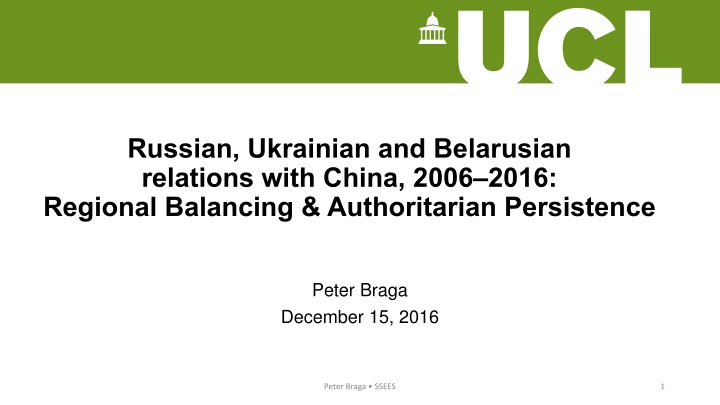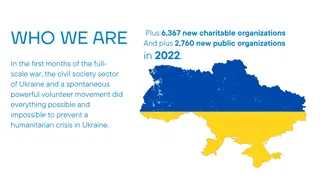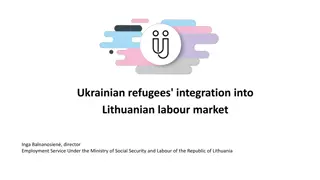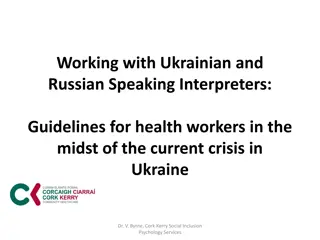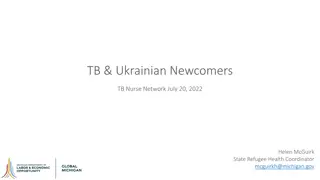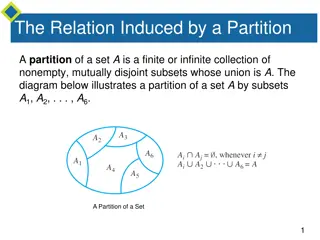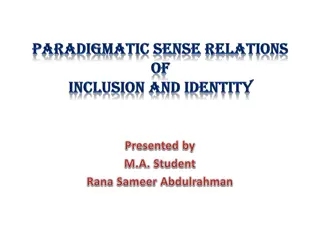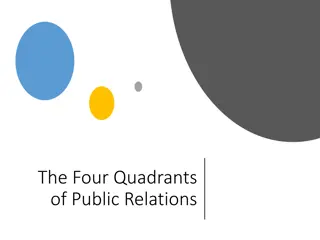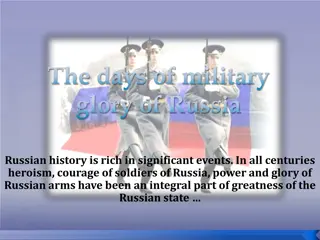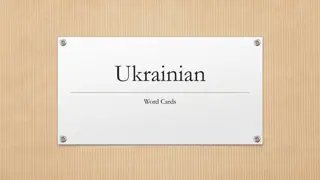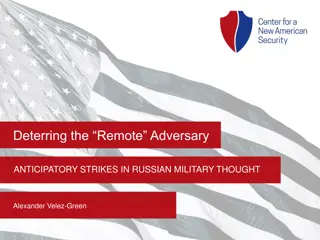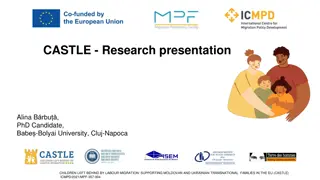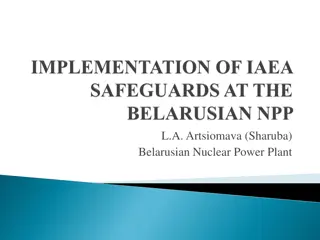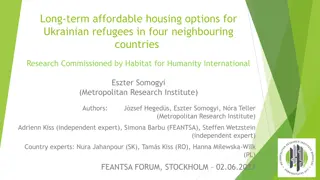Russian, Ukrainian, and Belarusian Relations with China: Regional Balancing & Authoritarian Persistence
This research explores how Russia, Ukraine, and Belarus utilize their ties with China to enhance authoritarian persistence. It delves into the impact of China on authoritarian regimes and its implications for regional relations.
Uploaded on Mar 09, 2025 | 2 Views
Download Presentation

Please find below an Image/Link to download the presentation.
The content on the website is provided AS IS for your information and personal use only. It may not be sold, licensed, or shared on other websites without obtaining consent from the author.If you encounter any issues during the download, it is possible that the publisher has removed the file from their server.
You are allowed to download the files provided on this website for personal or commercial use, subject to the condition that they are used lawfully. All files are the property of their respective owners.
The content on the website is provided AS IS for your information and personal use only. It may not be sold, licensed, or shared on other websites without obtaining consent from the author.
E N D
Presentation Transcript
Russian, Ukrainian and Belarusian relations with China, 2006 2016: Regional Balancing & Authoritarian Persistence Peter Braga December 15, 2016 Peter Braga SSEES 1
Outline Focus on 4 Aspects of My Research: 1. The Argument: Regional Balancing & Authoritarian Persistence 2. The Approach: Three Strategies 3. The Methodology: A Mixed Bag 4. Potential Problems: Arguments and Action Plans Peter Braga SSEES 2
Main Aim of Research Do Russia, Ukraine and Belarus use their bilateral ties with China to enhance authoritarian persistence? What is authoritarian persistence? How regimes use their position within the international system to promote internal stability and prolong non-democratic domestic rule. Peter Braga SSEES 3
Who cares? Applies a new perspective to understand changing contexts This study will contribute to existing research Modest contribution to unbalanced bilateral relations literature China s impact on authoritarian persistence understudied Implications for the European Union and regional relations Threshold of the OBOR into Europe Peter Braga SSEES 4
Contemporary Context China s rise in the region and the world Global authoritarian revival? China as an example for authoritarian regimes? China is Going Global Peter Braga SSEES 5
The Silk Road Project Figure 1: The Silk Road Project. This image has been modified from the original with permission. Source: TD architects. (2011). The Iron Silk Road, Mapping Cultural Space Across Eurasia. Retrieved from: http://eurasia.cga.harvard.edu/items/show/964 [accessed December 11, 2016]. Peter Braga SSEES 6
Definitions and Theory China s Rise and a Changing Context: Balance of Power Authoritarian + Persistence Connecting authoritarian persistence to external relations Selectorate Theory: Winning Coalitions and Staying in Power By nature, the winning coalition has external interests Peter Braga SSEES 7
Timeframe and Actors Timeframe: 2006 2016 China s Go Global Campaign Convergence of interest among actors Why Russia, Ukraine and Belarus? Why not Moldova? Why Russia? Peter Braga SSEES 8
Existing Research Foreign Relations (key studies) Regional Balancing (Cooley 2013; Snyder 1997; Walt 1991) R, U, B and China (Gabuev 2016; Lo 2015; Liu 2016; Shraibman 2014) Authoritarian Persistence Vanderhill and Aleprete (2013) Julia Bader (2015a, 2015b) Development of 3 strategies of authoritarian persistence Peter Braga SSEES 9
Strategy 1 + Methodology Patronage Bilateral Ties (interpretive data) Methodology: Measures depth of relations against regime survival and effectiveness of support Cox s proportional hazards model Cox s proportional hazards model (Everitt and Skrondal 2010, 112) Similar to Bader s (2015b) research, but my method includes effectiveness (Kindornay 2011, 18 19) Probit Analysis Peter Braga SSEES 10
Strategy 2 + Methodology Authoritarian Learning: The China Model the copying or sharing/trading of policies (formal or informal) promote autocratic regime survival Methodology: Discourse Analysis (Speeches and Interviews) what the Chinese Model looks like when it lands (Fourie 2015, 295) Official Speeches and texts BUT is praise for China model just lip-service? Peter Braga SSEES 11
Strategy 3 + Methodology International Coordination (Ambrosio 2009; Vanderhill 2013, 220) Methodology: cooperation at the international level Voting behaviour at the United Nations (cohesion among actors) (Yelisiyev 2013; ) Proposals to enhance regime stability within the Shanghai Cooperation Organisation (Ambrosio 2009) Peter Braga SSEES 12
Potential Problems 1. Negative Results 2. Adjusting the Strategies 3. Outliers: Russia and Ukraine 4. Originality? Peter Braga SSEES 13
Research Timeline Pre-Upgrade (development of bilateral relations: case studies) Testing Phase statistical models (the first and third strategies) Research Phase (gathering and analysing data) Writing Phase Peter Braga SSEES 14
References TD architects. (2011). The Iron Silk Road, Mapping Cultural Space Across Eurasia. Retrieved from: http://eurasia.cga.harvard.edu/items/show/964 [accessed December 11, 2016]. Cooley, A. (2012). Great Games, Local Rules: The New Great Power Contest in Central Asia. New York: Oxford University Press. Snyder, G. (1997). Alliance Politics. Ithaca, NY: Cornell University Press. Walt, S. (1990). The Origins of Alliances. Ithaca, NY: Cornell University Press. Gabuev, A. (2016a). A Pivot to Nowhere: The Realities of Russia s Asia Policy. The Carnegie Moscow Center. Retrieved from: http://carnegie.ru/commentary/2016/04/22/pivot-to-nowhere-realities-of-russia-s-asia-policy/ixfw. Lo, B. (2015). Russia and the New World Disorder. Washington, DC: Brookings Institution Press. Liu, Z. K. (2016). The Analysis of the Relationship between China and Ukraine. CEEC. Retrieved from: http://16plus1-thinktank.com/1/20160111/1095.html. Shraibman, A. (2014). Belorussko-kitaiskie otnosheniia: ozhidaniia, problemy i perspektivy [Belarus-China Relations: Expectations, Problems and Outlooks] (Report No. 2014). Retrieved from the Friedrich Ebert Stiftung Foundation: Ukraine Bureau: http://library.fes.de/pdf-files/bueros/ukraine/11022.pdf. Bader, J. (2015a). China s Foreign Relations and the Survival of Autocracies. New York: Routledge. Bader, J. (2015b). Propping up dictators? Economic cooperation from China and its impact on authoritarian persistence in party and non-party regimes. European Journal of Political Research, 54, 655 672. doi: 10.1111/1475-6765.12082. Vanderhill, R. (2013). Conclusions: The International Dimension of Authoritarian Persistence. In Rachael Vanderhill and Michael E. Aleprete Jr. (eds), International A252:J418 of Authoritarian Persistence: Lessons From Post-Soviet States (219 229). Plymouth, UK: Lexington Books. Fourie, E. (2015). China s example for Meles Ethiopia: when development models land. The Journal of Modern African Studies, 53, 289-316. DOI:10.1017/S0022278X15000397. Yeliseyev, A. (2013). Some Aspects of Belarusian-Chinese Relations in the Regional Dimension: Much Sound and Little Sense (Report No. SA #08/2013RU, 9 April, 2013). Retrieved from the Belarusian Institute for Strategic Studies: http://belinstitute.eu/sites/biss.newmediahost.info/files/attached-files/BISS_SA08_2013en.pdf. Ambrosio, T. (2009). Authoritarian Backlash: Russian Resistance to Democratization in the Former Soviet Union. Farnham: Ashgate. Peter Braga SSEES 15
Q&A Preparations Slides to prep: My 3 core concepts Philosophies underpinning research methods Detailed explanation-slides of methods for each strategy, including formulas Regional Justification Timeframe justification My research questions Why I don t have ethical considerations, logistical issues or high risk worries Drive home what puzzle my dissertation solves Is my study reproduceable? Can others use it? Peter Braga SSEES 16
